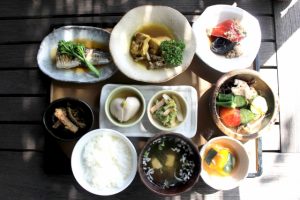What Were the People in Long-Lived Villages (Japanese Blue Zones) eating?
The people in short-lived villages were eating a lot of white rice without vegetables and seaweed, what about the people in long-lived villages? They weren’t eating white rice. Then what were they eating instead?
They were eating Mugimeshi, rice with barley. It was a common custom in many parts of Japan because rice was a luxury. Only the wealthy and rice growers ate rice. Even for rice growers, rice was their commodity, and some of them ate other grains at home.
It was a common practice in Shiga, too. Another doctor called Tsuneo Matsuike hypothesized that Mugimeshi was one of the causes behind the people of Shiga’s longevity in his book Nihonichi No Chojuken To Sekaiichi No Chojumura No Cho Ni Ii Shokuji, The Gut-Friendly Diets of Japan’s Number One Longevity Prefecture and The World’s Number One Longevity Village.
In Ogimi village, they eat a lot of sweet potatoes as their staple instead of white rice. Sweet potatoes are staples in many villages in Okinawa, Amami-Oshima, Kyushu, and Shikoku. Therefore Mugimeshi and sweet potatoes are common staples among long-lived villages.
They ate a lot of vegetables, soybeans, and seaweed.
According to Dr. Shoji Kondo, the author of Nihon No Chojumura Tanmeimura, Long-Lived Villages and Short-Lived Villages in Japan, the key component in the diets of long-lived villages were vegetables, soybeans, and seaweed.
Therefore, people in long-lived villages ate a lot of vegetables, soybeans, seaweed, and their main source of carbohydrate was rice with barley and other grains or potatoes such as sweet potatoes. Some of them ate fish but usually, they ate small fish, not big fish.
That reminds me of MA GO WA YA SA SHI I, which is a popular diet among the health-conscious people in Japan today.
Also, the diets of long-lived villages are very similar to Washoku today, except they didn’t include white rice.

Modern-day Washoku consists of white rice, vegetables, soybeans, seaweed, fish, and potatoes of all kinds such as sweet potatoes, and taros.
In the past, however, there wasn’t a standard Washoku, people ate differently based on their geographic locations and traditions. From the 1930s to ’70s, when Dr. Kondo conducted his research, the location was relevant, since there were distinct differences among the diets of each region, due to the availability of ingredients. Nevertheless, today most people have access to all kinds of food regardless of where we live. Back then, only some villages had access to fish and seaweed because they were on the coast, but now, we can get seafood everywhere in Japan: Most places are located within a two- to three-hour drive from the coastline in Japan, which makes us one of the biggest fish consuming nations in the world. In the past, many poor villages couldn’t afford to buy rice unless they were rice growers, but today, everybody eats rice. In the past, some fishing villages didn’t have any space to grow vegetables and ate only rice and fish, but today everybody can eat vegetables. Consequently, today in the rural areas, whether they are fishing villages or rice-growing areas, or mountain regions, they eat regular Washoku, the Japanese food, consisting of white rice, seafood, soybeans, and vegetables.
Thus modern-day Washoku is much healthier and more well-balanced than the diets of short-lived villages but it is not as good as the diets of long-lived villages since we eat a lot of white rice.
Recently, white rice is criticized among low carb diet advocates, and this custom of eating white rice is questioned, but for many years, white rice was believed to be the soul of our culture.
So, what does it mean? Is Washoku good for us or not?
Who are the healthiest people in Japan? Or what is the healthiest Japanese diet?
To answer this question, we need to look into Washoku more in-depth. Washoku doesn’t mean simply eating white rice, seafood, soybeans, and vegetables. The way they are eaten is significant.
Washoku has been registered as a UNESCO Intangible Cultural Heritage of Humanity, for the following characteristics.
1.Diversity and freshness of ingredients, and respect for their inherent flavors.
2.An exceptionally well-balanced and healthy diet.
3.An expression of natural beauty and the changing seasons.
4.Close links with annual events.
One of them is being a well-balanced and healthy diet.
In that case, what aspects of Washoku are well-balanced and healthy?
The Ikigai Diet: The Secret Japanese Diet to Health and Longevity
POD Paperback
https://www.amazon.com/gp/product/4991064864
Kindle
https://www.amazon.com/dp/B08JGB45HF

